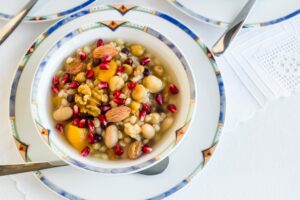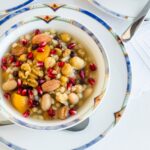

Anoush Abor
To round out the holidays –and- to satisfy your body and soul during this festive season, there is one recipe that cannot be ignored: Anoush Abour. It’s a sweet, fruity, nutty delicacy to be savored with loved ones.
The recipe I’m offering comes from Yerchanig Joy Callan, wife of Roy Callan, Executive Director of Camp Haiastan in Franklin, MA. Her recipe is one of the dessert selections in the recently released cookbook, “Armenian Cuisine: Preserving Our Heritage”, from St. John’s Armenian Church, Southfield, Michigan.
Joy suggests cooking the fruit separately from the other ingredients and adding it when cooled to keep the pudding’s appearance an appealing pearly white. Joy also confided that the longer the pudding sets, the thicker it becomes. To loosen it up a bit, stir in a little simple syrup (the kind you drizzle on paklava) before serving.
This dish is a MUST-have at any Armenian Christmas (January 6th) celebration.
PS: Don’t forget: According to our friend Ara, tonight, Jan. 5th, you should be serving Nevik – Swiss Chard with Chick Peas!
Soorp Dznoont!!


Sts. Vartanantz Day is a moveable celebration on the Armenian Church calendar. This year it…
Just in time for soup season, Christine Datian offers The Armenian Kitchen her recipe for…
I don’t know about you, but in our family, we’re all about tradition when…
It’s that time of year again! St. Sarkis Day, the moveable feast day on the…
Way back in 2010 Ara Kassabian shared his family’s recipe for Nevik with The Armenian…
With Thanksgiving Day just hours away, I thought I’d share a few of our favorite,…
This website uses cookies. find out more.
View Comments
There is a similar recipe in Alice Antreassian's cookbook. She recommends that you peel the pistachios in order to maintain the color of the pudding. She also suggests to arrange whole blanched almonds in the form of a star on top of the pudding.
Incidentally, in Aintap, we do a simpler form of the pudding using rice. It is very simple: Per cup of water, use 1/4 cup short-grain rice, 1/4 cup sugar, 1 clove, 1/2 stick cinnamon, a little bit of honey (mostly for color). Cook until the rice is soft and starting to fall apart. Place in a bowl and let it cool. Garnish with almonds, walnuts, cinnamon, etc. (Note: I put the proportions from memory; I will double-check and correct if necessary).
Out of curiosity, is Mrs. Callan's family Bolsetsi?
My mum used to call a yogurt soup Abour. Which was made with yogurt and dill. I was brought up with Armenian traditional precipices, and this version of Apour was not one of them. This must be the Westernized version the sweet version not the savory one.
'Abour' means soup, which could be either sweet (as in Anoush Abour) or savory (as in Tahn Abour). It isn't a westernized recipe.
I love Anoush Abour...i had no idea it was such a lengthy process. I was hoping to make it when i get home to have tonight! Oh well...thanks for the recipe! Pari Gaghant!
Ara, Thanks for the 2 recipes - A. Antreassian's and yours. Your version sounds pretty simple and quick; I must give it a try. As for Mrs. Callan's background, here is her response:
"I am from a "mixed" marriage; Yozgatzi and Gesaratzi. But, lucky me, as my husband's family reminded me on several occasions, I married 'up' as his family is Izmirzi."
NK, if time is of the essence, try Ara's recipe above using short-grain rice. It sounds similar, but without the lengthy time factor.
This comment has been removed by the author.
Hello, i am from istanbul , living in los angeles. when we make anoush abour , we add rose water after anoushabour cooks and removed from the heat. my husband likes it so much , im going to make another batch this week...
congratulations on your blog, it gives me an incentive to start one also. as armenians we needed a cooking blog. you are doing a great job :)
karin
Karin, thank you for your encouraging words!
Adding rose water to anoush abour would make it super-tasty.
I am Kesaratsi, Aintabtsi, from Izmir, from Yozgat - please stop and getb a reality check. No one can say they "are from" western Armenia and Anatolia any more. Food is a convenient reminder of our roots but no substitute for the real thing that has vanished....Otherwise love your site.
Armenian in limbo
If you believe that, then yes we are vanished and don't have a case! For a moment it occurred to me that this was a non-Armenian voice speaking. We are talking about our roots here, roots that so many people go to great lengths to find out. It is an identity, not lost, because we remember and never forget. It is recorded and engraved history being told, in writing and word of mouth. My father comes from Hadjin, and mother from Kilis. They all have sad stories to tell. Can I ever forget that?
unfortunately within the armenian community one always says whether they are from western or eastern countries first.largely due to fact that where we come from effects the way we speak , cook and follow certain traditions. especially in Los Angeles one boasts about lebanese armenian , hayastansi armenian, persian armenian restaurants , bakeries, churches or stores.
one way of coming out of the limbo is to embrace and accept where you came from, and dont turn a cooking site into a political arena....
even americans differentiate how to cook ribs according to regions (texas, mississippi etc)
I add rosewater at the end, too.
Also, it adds a dimension of taste to the wheat if you throw a couple of whole cloves and a stick of cinnamon into the boiling water.
A friend from Sivas makes it with pearl barley. After boiling, she runs the barley through a food mill or sieve and then adds the fruit, so it's more of a smooth pudding or compote.
There are so many national variations of this food, often served at Christmastime and other winter feasts: Kolliva in Greece and the Balkans, German and English farina puddings with raisins, kutia wigilijna in Poland, payasam or shira in India. I suspect it is an ancient food. Someday I would like to create a cookbook with nothing but anoushabour recipes!